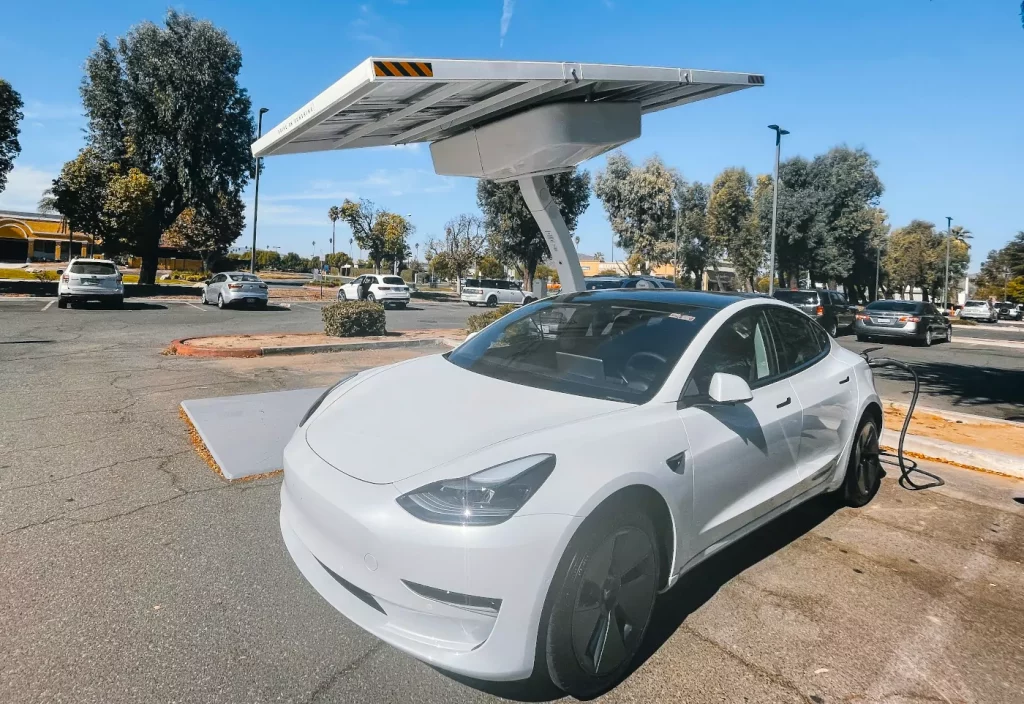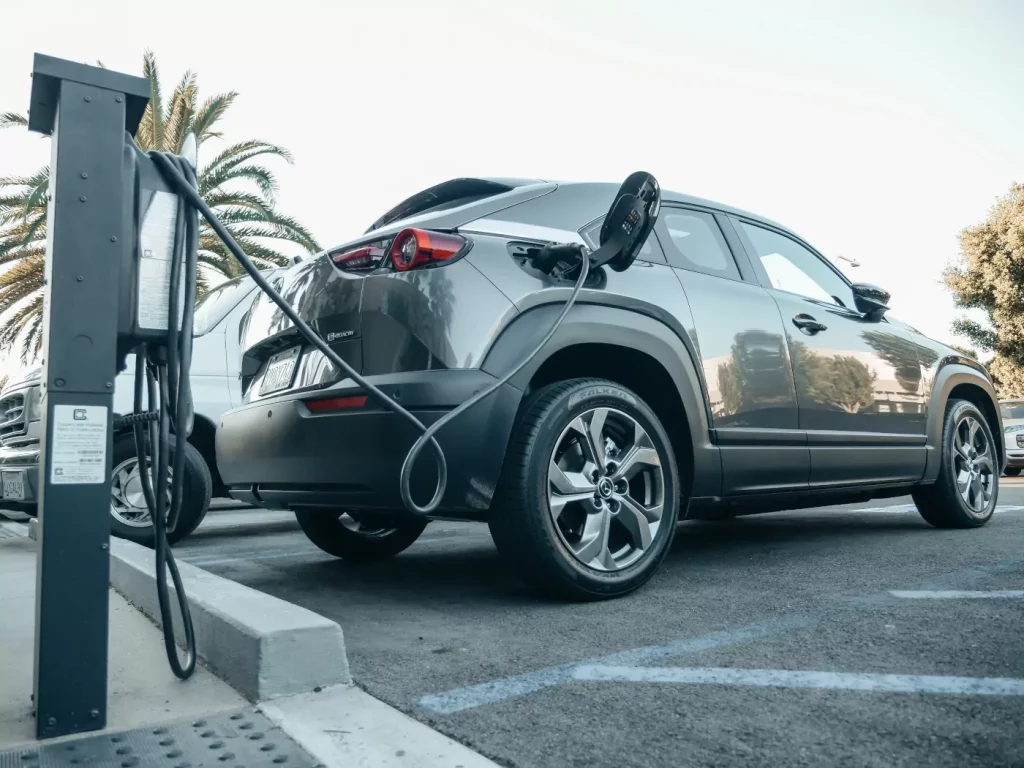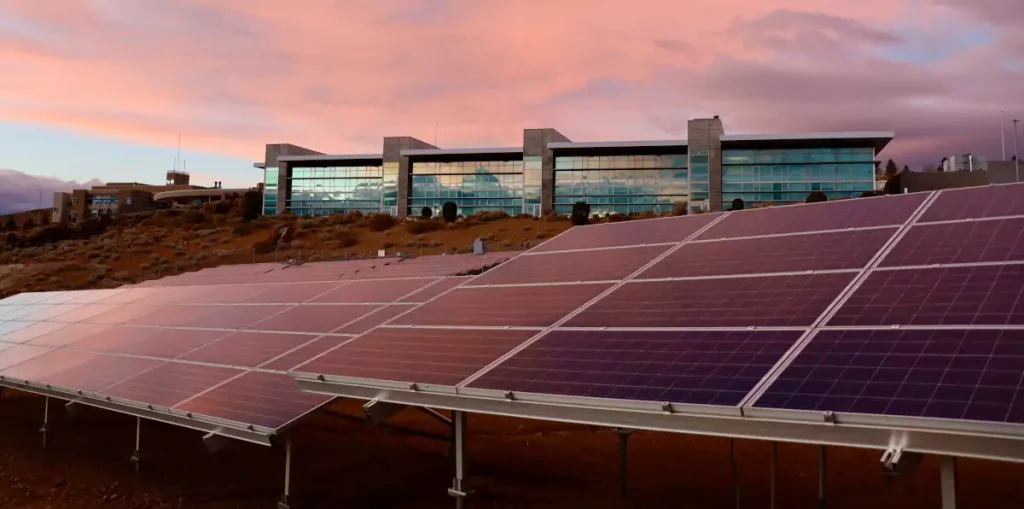The post Electric Vehicles and Solar appeared first on Sky Energy.
Currently, EVs, or electric vehicles, only make up a small percentage of cars sold in Australia; however, most major car companies are either manufacturing or otherwise developing electric vehicles, and plug-in hybrids (PHEVs) as the uptake is expected to rise considerably over the next 5-10 years.
Driver’s main concerns when considering the switch to an EV are price, charging, and range, all constantly improving. The amount of benefits such as lower maintenance and low running costs means purchasing an EV is becoming more attractive each day. When factoring in an existing rooftop solar system and solar batteries to charge your EV means technically eliminating fuel costs from the equation.

Charging an EV with solar
In the same way efficiency and running costs for conventional vehicles can be measured in litres per 100km, we can apply a similar formula of kWh per km to electric vehicles.
The average EV range is about 6km per 1kWh, and the average Australian drives about 50km per day, which means their electric vehicle will require about 8kWh of charge. EV’s battery sizes range from 24kWh up to 100kWh or more. The most common battery capacity is around 65kWh, which provides a driving range of about 390km.
1kW of solar capacity produces about 4kWh of energy (depending on the season and weather), so to offset the charging of an EV driving 50kms per day would require around 2kW of solar panels. Owners should also expect a slight loss in the energy generated and how much charge makes it to the actual battery pack due to inefficiencies in panels, inverters and the car’s battery.
Using a smaller 5kW rooftop solar system and a regular 10A Level1 plug-in charger is relatively simple; however, charging an EV with a more powerful level 2 charger can be more difficult even with a large solar array. This is because these larger systems may not always generate enough charge at full power for the level 2 charger when production is being impeded by adverse weather, for example. There are existing options to mitigate these issues, such as smart EV chargers and bi-directional chargers, which we will cover in this article.

Types of EV Charger
EV chargers are generally grouped into three distinct types identified by ‘level’:
Level 1 – Portable 10A plug-in chargers up to 2.4kW
Level 1 chargers come standard with most EVs and can be plugged into an ordinary 10A socket at home. Up to 2.4kW.
Level 2 – Dedicated wall-mounted chargers 5kW up to 22kW
Level 2 are compact wall-mounted chargers, also known as a wallbox charger and are usually wall-mounted permanently on homes or businesses. From 5kW up to 22kW.
Level 3 – Roadside EV charging stations 50kW up to 300kW (DC fast chargers)
Level 3 are the powerful, fast DC chargers used at dedicated roadside charging stations. From 50kW up to 300kW.
Additionally, the two types of home chargers (level 1 and level 2) can be further categorised into:
Plug-in 10A socket chargers – 1.4kW to 2.2kW (Level 1)
A typical EV will come equipped with a basic level 1 charger that can use a standard 10A wall socket. These small, portable chargers will require 20 to 36 hours to recharge an average EV, depending on the initial state and battery size. Most of these 10A chargers will charge at a rate of 2.2kW max but usually will draw from 1.7kW to 2.0kW, adding approximately 10 – 14kms of range per hour.
Single-phase EV charger – 3.3kW to 7.2kW (Level 2)
Level 2 single-phase EV chargers are commonly mounted on a wall or post and are available in various designs and options. They are generally rated at 32 Amp, the equivalent of 7.4kW of energy, and can provide an EV with a 40 to 50km range per hour at a full charge rate.
To fully recharge an average EV in 8 to 10 hours using a regular single-phase level 2 charger is achievable.
Three-phase EV charger – 9.0kW to 22.0kW (Level 2)
Level 2 three-phase home chargers look identical to the single-phase wall-mounted chargers and are usually rated at 32 Amps. Due to being 3 phase, these can supply three times the power as a single-phase device, equivalent to 22kW of charging power. This can provide a vehicle with a range of 120 to 150km per hour Using a maximum charge rate. Fully recharging an average EV can be done in less than 3 hours using a 3-phase Wallbox charger.
However, charging an EV using a 3-phase charger at 22kW can be problematic, even with a large 16kW+ system, especially during cloudy weather. The solution is to use a three-phase EV charger set to a lower charge rate (12kW, for example) or a three-phase smart EV charger that can dynamically adjust the charge rate, matching the solar output.
Combined solar inverter and EV charger – 5.0kW to 7.4kW (Level 2)
Combining an inverter and EV charger, this smart solution eliminates the need for a separate charger and additional wiring and electrical upgrades. However, the inverter needs to be installed close to the vehicle. SolarEdge is one of the first to manufacture a combined inverter and charger which can handle up to 7.4kW simultaneously from the solar system and the grid.

How long will it take to charge an EV?
This will depend on several factors such as the solar system size, the EV battery capacity and weather/season conditions. To charge an average EV 20-80% would take approximately a day using a standard 6.6kW rooftop system. The more energy produced, the better for charging, especially if there are other variables such as cooler weather or less available sunlight hours. If you drive under 80 km per day, charging from solar will be reasonably straightforward.
Rooftop solar arrays, for example, larger than10kW combined with a powerful 7kW Type 2 charger, can charge an EV up to 80% in about 6 hours, while an even more powerful 3-phase charger and solar array producing 15kW could charge an average EV in 4 hours. These charging times assume that the load from other household appliances is low, and the weather is sunny. To avoid paying for grid power to charge your EV, it is possible to use a Smart EV charger.
Smart EV chargers
Smart EV chargers utilise smart charging modes and optimise how and when to charge your EV. Options can include scheduling your charger to automatically charge during off-peak times and also when electricity prices are lower, boost charging and solar only charging. Smart app-controlled chargers can monitor your energy generation, and rather than exporting excess solar to the grid; they will divert it to your EV charger.
Standard home EV chargers draw at a fixed rate, usually around 3.5kW to 7.4kW, depending on the type of charger and charger settings. When charging from solar, the energy generated can be less, often during cloudy weather. Smart EV chargers fix this problem by using a metering device known as a CT clamp mounted near the main electrical connection and monitoring the grid’s energy flowing in and out.
When it detects the excess energy flowing out to the electrical grid from your solar, it charges the EV that specific amount. The charge can vary due to the change in energy consumption and solar generation. This is when the smart EV charger can automatically adjust the charge rate to match the excess solar generation.

V2G and V2H Bidirectional Chargers
V2G is an emerging technology that is becoming more popular where the charger operates vehicle-to-grid or V2G using a ‘bidirectional charger’. These chargers allow energy to flow to and from an electric vehicle. A standard charger only sends energy in one direction when charging. In contrast, bidirectional chargers can also power your home or help balance the grid by drawing power from your vehicle, such as in times of high demand.
Vehicle-to-home or V2H is another more recent developing technology, similar to V2G, but the energy is used to power your home and the EV functions like a solar storage battery. To work, the EV needs to have two-way charging enabled.
The amount of EVs with two way charging on the market is increasing; however, only a few, such as the Nissan Leaf, offer this option. It is becoming more common in newer EVs and takes advantage of the car’s sizeable solar battery to store excess energy and power your home directly from your vehicle. Check the RACV website for more information about Bi-directional chargers.
V2L Charging
Vehicle-to-load or V2L technology is more straightforward and does not require bidirectional chargers to operate. V2L is simply the ability to plug appliances directly into standard outlets built into the vehicle. EVs offering V2L technology supply AC power and can be used as backup power in a blackout or an emergency. For example, an EV with a 60kWh or larger battery in a fully charged EV could supply a regular household for several days.
3-Phase vs Single-Phase
The two main types of grid connection for homes are single-phase and 3-phase. While single-phase is generally limited to 15kW or 63A maximum, a 3-phase connection can supply up to 45kW (3 x 63A).
Most homes in Australia are single-phase with a 220 to 240V supply, and the maximum energy able to be supplied from the grid is typically 12kW to 15kW (50A to 63A). However, it not possible to utilise the full grid capacity to charge an EV because you will not be able to use other appliances simultaneously. Otherwise, the grid supply switch would overload and trip. This is why most single-phase EV chargers are limited to 32A or around 7kW, which is not a problem unless you need a fast charger.
With a 3-phase power supply, it is possible to power one or more 22kW EV chargers and is more suited to commercial businesses with higher energy capacity and generation.
The post Electric Vehicles and Solar appeared first on Sky Energy.
















